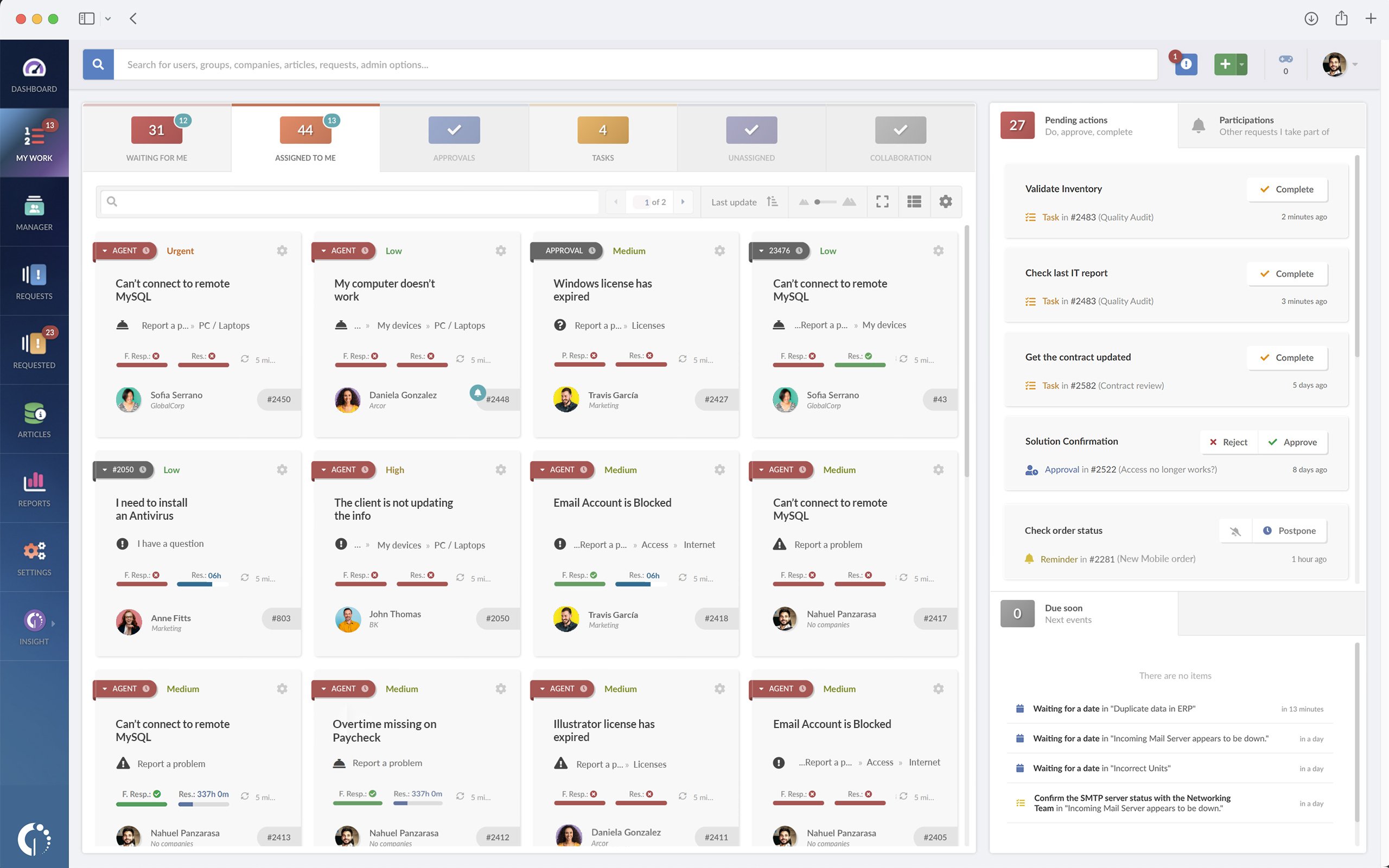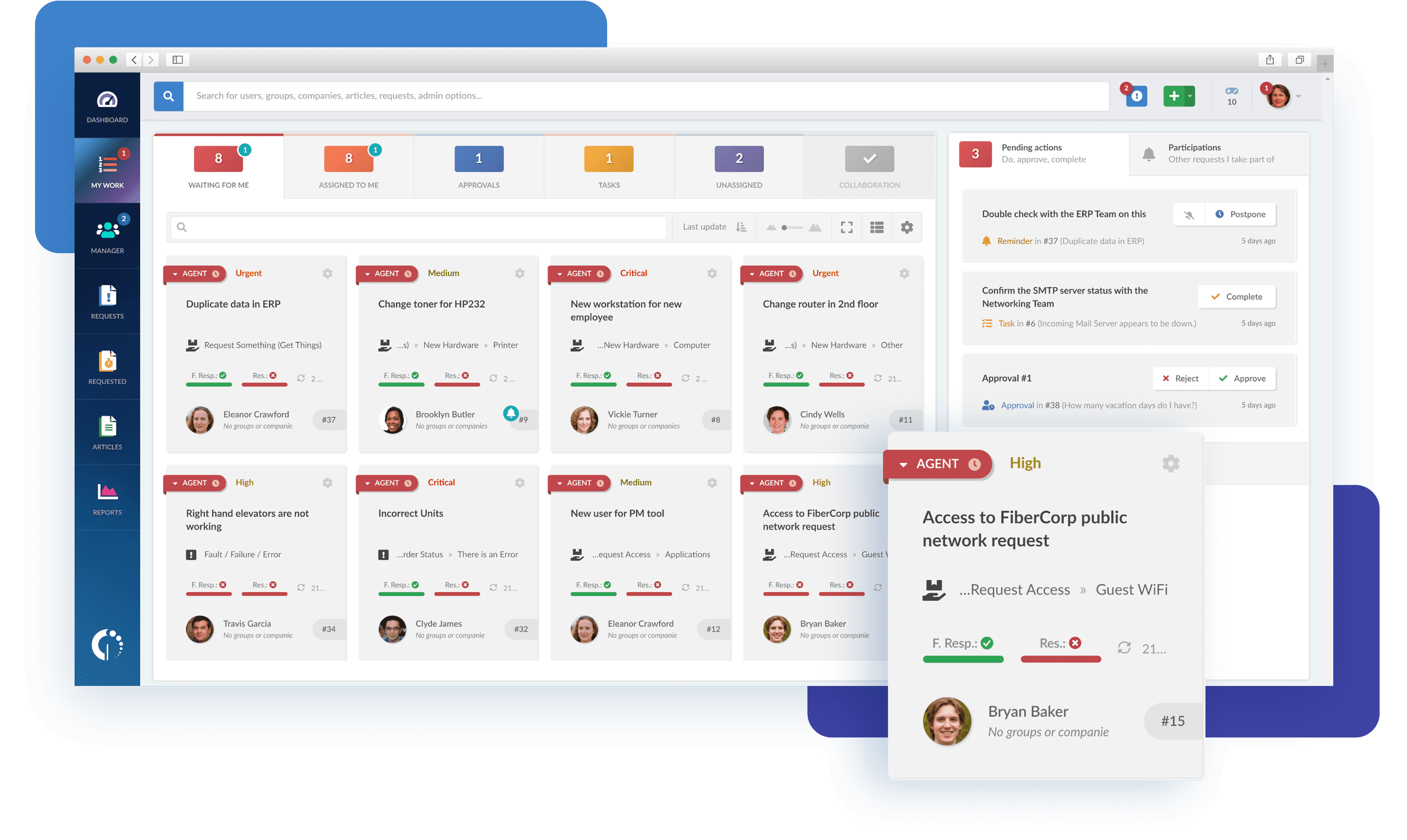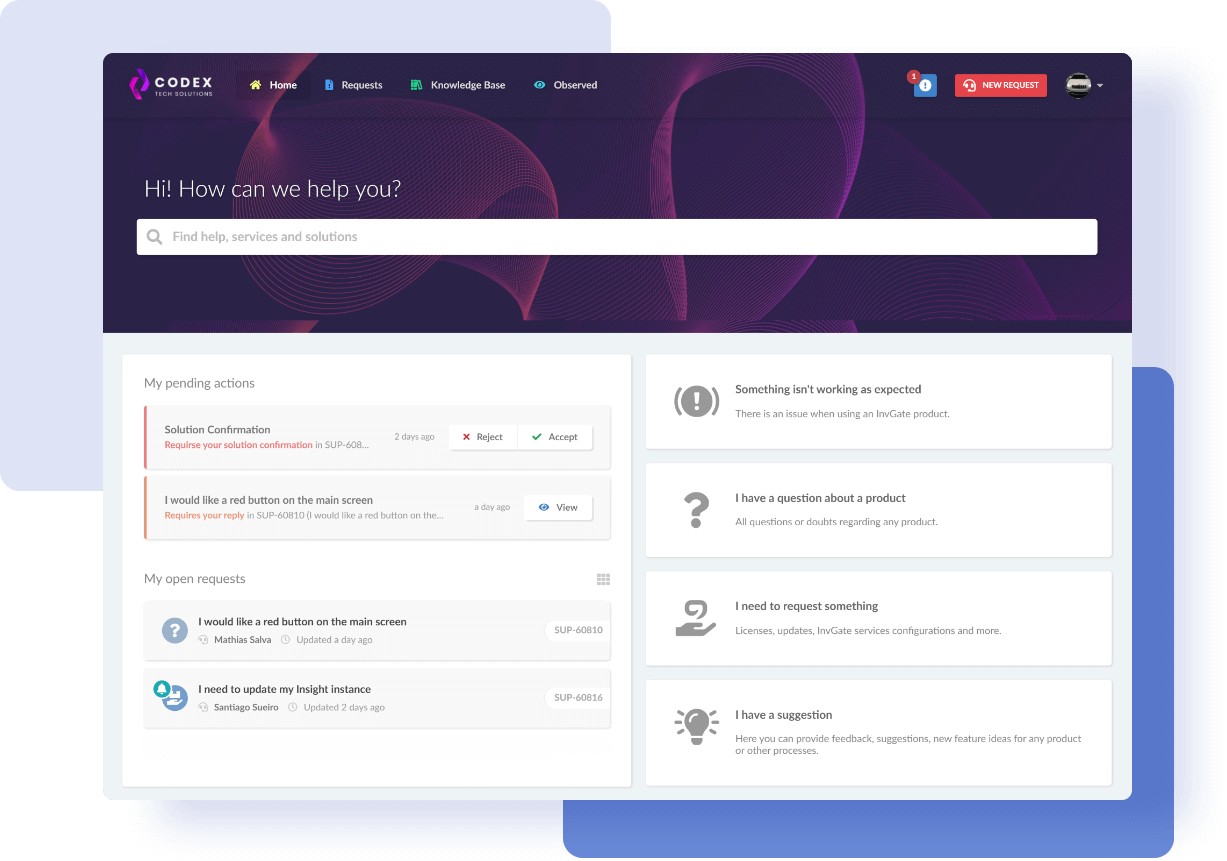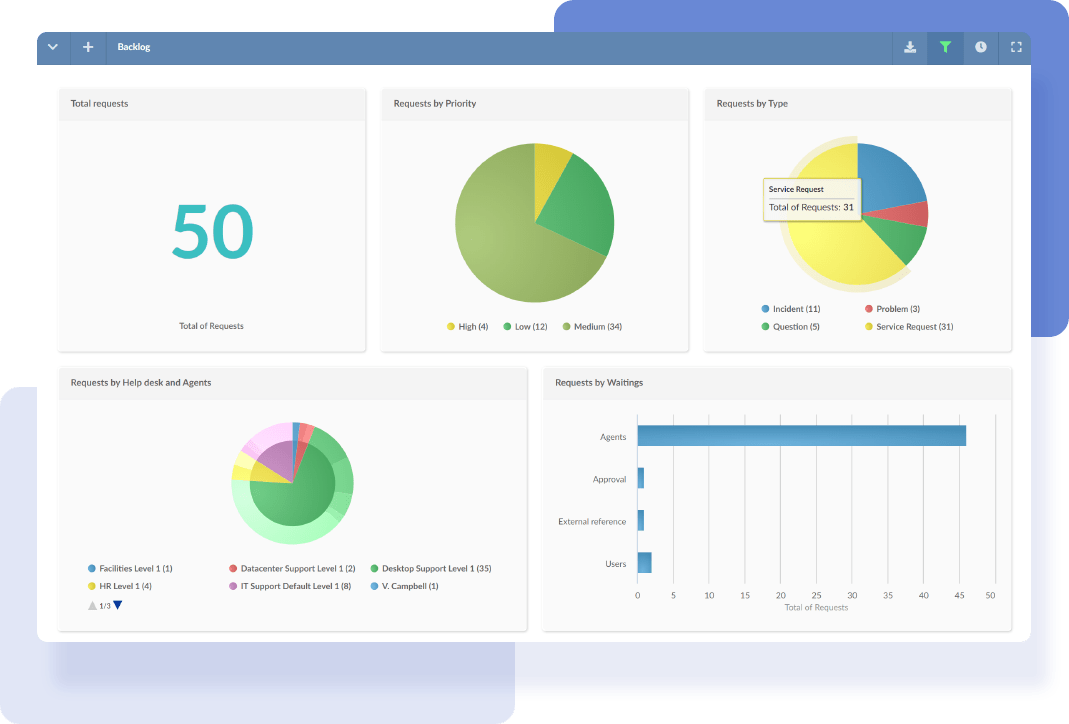If you are at the crossroads of SymphonyAI Summit Service Management vs. Microsoft System Center Service Manager, you should thoroughly analyze their merits and capabilities. Your IT Service Management (ITSM) solution can significantly impact your organization's IT services and operational efficiency.
In this blog post, we’ll embark on a comprehensive ITSM tools comparison of these two platforms.
However, amidst the competition between these two prominent contenders, a compelling alternative emerges— InvGate Service Management. With its streamlined functionalities, this service desk software offers organizations a distinctive opportunity to elevate their IT operations to new levels of efficiency and effectiveness.
Keep reading to uncover the ideal ITSM solution for your organization's needs.

Table of contents
- TL;DR
- What is SymphonyAI Summit Service Management?
- What is Microsoft System Center Service Manager?
- Considering InvGate Service Management as an ITSM solution alternative
TL;DR
- SymphonyAI Summit Service Management offers flexibility, rich ITIL-aligned features, user-centric design, and cost efficiency, but faces concerns over platform performance, configuration limitations, and customer support.
- Microsoft System Center Service Manager has received positive customer feedback for its comprehensive modules, simple implementation, and automation and integration. However, it has also been said that there is variability in its support quality, and there can be scalability challenges and limited customization options.
- Lastly, InvGate Service Management is recognized for its flexibility and scalability, Low-Code/No-Code capabilities, and ease of use. In addition, it offers multiple automation features, native, third-party, and API integrations, short implementation times, and outstanding support.
We tried to be as thorough as possible, but if you don't have enough time to read it through and through, here's (another) TL;DR: InvGate Service Management can do everything we say here, and you can test it right away for free for 30 days.
Most looked-at features by buyers
When evaluating IT Service Management solutions, potential buyers focus on specific features that align with their organization's needs. Understanding these desired functionalities is crucial for making well-informed decisions.
Let's delve into the key aspects prospective buyers commonly consider when comparing ITSM tools.
- User-friendly experience and interface - Ease of use and interface design are critical factors for buyers. They value a user-friendly platform with an intuitive interface that enhances user adoption and productivity. Mobile accessibility is also important, especially for organizations with remote or mobile workforces.
- Ticket Management System - Prospective buyers attach significant importance to a comprehensive Ticket Management system within the help desk software. This feature enables the efficient tracking, assignment, and resolution of customer inquiries and support requests.
- ITIL compliance - Adhering to ITIL best practices is a priority for many organizations. Buyers may prioritize solutions that support ITIL processes, including Incident Management, Problem Management, Change Management, and Asset Management.
- Efficient IT Asset Management - Users prioritize software that offers robust IT Asset Management (ITAM) capabilities. This helps them maintain accurate inventories and optimize resource utilization within their organizations.
- Scalability and personalization - Organizations with evolving needs prioritize solutions that can adapt to their growth and allow for customization. Buyers seek the ability to create custom fields, workflows, and extensions/plugins to cater to their specific business requirements.
- Simplified IT service catalog - Organizations often require an uncomplicated IT service catalog that offers a centralized platform for users to request specific IT services or resources. This feature simplifies service requests, enhances visibility, and facilitates efficient service delivery management.
- Seamless integration capabilities - The ability to seamlessly integrate with other systems and applications is a critical requirement for buyers. They seek smooth data flow and automated processes, valuing the capability to integrate with existing tools and platforms for improved efficiency and a unified user experience.
- Self-service portal and knowledge base - The inclusion of a self-service portal is highly valued as it empowers end-users to independently resolve common issues and access relevant information without requiring direct assistance.
- Informative reporting - Buyers look for help desk software with robust reporting tools such as dashboards and reports. These features provide valuable insights into IT operations and performance, facilitating informed decision-making and continuous service improvement.
- Customization and adaptability - Buyers appreciate software solutions that can be tailored to their business needs. This ensures that the software aligns with their unique workflows and processes, leading to increased user satisfaction and overall efficiency.
- Support automation and Workflow Management - Buyers actively seek software solutions that offer automation capabilities to streamline routine tasks like ticket routing, approvals, and escalations. These automation features contribute to increased efficiency and productivity.
- Cost and support - Buyers consider the solution's cost-effectiveness, including licensing models, subscription plans, and additional costs for features or users. Reliable customer support, comprehensive documentation, and accessible training resources also influence decision-making.
What is SymphonyAI Summit Service Management?
SymphonyAI Summit Service Management, provided by the company SymphonyAI Summit, offers an ITSM solution that aligns with ITIL standards and incorporates cutting-edge AI-driven digital agents and automation.
Additionally, SymphonyAI Summit, which was founded in 2015 and headquartered in Pune, India, has expanded its product range to include an IT Asset Management solution, covering Lifecycle Management, expense management, and the avoidance of unnecessary acquisitions.
What users like from SymphonyAI Summit Service Management
SymphonyAI Summit Service Management has garnered favorable reviews from sources like Gartner. Let's delve into some of the highlighted advantages mentioned in these evaluations.
- Rich feature set - Users highly value the platform's extensive feature set. It adheres to ITIL standards, offers pre-built reporting capabilities, facilitates user-friendly ticket relationship management, supports automation through orchestration, and integrates AI functions, all contributing to its appeal.
- User-friendly experience - Users consistently praise SymphonyAI Summit Service Management for its easy-to-use interface, intuitive dashboard layout, and a strong commitment to simplicity.
- Flexibility and adaptability - This solution empowers users to efficiently handle workflows and support tasks, enabling dynamic adjustments to meet evolving needs. Implementing suggestions is a straightforward process, fostering a culture of continuous improvement. Users also appreciate the platform's simplicity in configuring changes, conditions, and validations.
- Multichannel engagement - The software excels in automating workflows and seamlessly connecting Incident Requests (IR), Service Requests (SR), and Change Requests (CR) with assets and configuration items. Its robust resource-handling capabilities enable efficient management of a wide range of resources.
- Cost-effective solution - SymphonyAI Summit Service Management is recognized for its cost-effectiveness compared to competitors. Users find value in the platform's pricing structure, which delivers robust features and capabilities.
- Training and support - The training team is highly praised for their expertise and effectiveness in knowledge transfer. The platform's support services are known for their timeliness and ability to address users' queries and challenges promptly.
- Asset Management excellence - The platform's ITAM capabilities provide users with a comprehensive and user-friendly experience. Features like mail-to-ticket and mail-to-service request (SR) functionality, combined with extensive ITAM tools, enhance efficiency in Asset Management processes.
What users don’t like from SymphonyAI Summit Service Management
While SymphonyAI Summit Service Management has many strengths and positive attributes, there are certain areas where users have expressed reservations and criticisms, as evidenced by reviews from sources such as Gartner. Let's explore some of the issues that have drawn attention.
- Reliability doubts - The platform's reliability has been scrutinized by certain users, prompting calls for more rigorous testing to enhance overall stability.
- Limitations in customization flexibility - Although the platform does offer customization options, users have reported encountering specific constraints that hinder their ability to achieve desired levels of customization in certain areas.
- Performance and accessibility problems - Users have pointed out accessibility issues, including instances where the tool becomes inaccessible for extended periods and experiences significant performance slowdowns. Recommendations have been made to enhance application response times.
- Bug-related issues - Reports of bugs causing conflicts between different teams' data containers have surfaced, impacting the overall reliability and stability of the system.
- Configuration challenges - Concerns have been raised regarding the platform's configuration capabilities, workflow management, and administrative functions. Some users have suggested that improvements and enhancements are needed in these aspects.
- Responsiveness concerns - Another prevalent concern revolves around the performance of the web interface, with users reporting issues related to speed and overall responsiveness. There have also been instances where essential enhancements seemed to be given less attention.
- Customer support shortcomings - Some users have expressed dissatisfaction with customer support, citing concerns such as delays in service requests for reports, extended support timelines, and difficulties related to bug resolution and product updates.
- Costs and licensing - Some users find the licensing costs relatively high and have made comparisons with other tools available in the market.
- Additional recommendations - Users have brought up a couple of specific points. Firstly, there is a desire for an alert or reminder feature within the platform. Secondly, comments have emerged regarding the need for improved platform documentation.
What’s SymphonyAI Summit Service Management’s argument over Microsoft System Center Service Manager?
SymphonyAI Summit Service Management presents a compelling argument when compared to Microsoft System Center Service Manager, particularly in areas where it outshines its competitor.
- Rich feature set - Users highly value SymphonyAI Summit Service Management's extensive feature set. It not only adheres to ITIL standards but also offers pre-built reporting capabilities, user-friendly ticket relationship management, automation through orchestration, and integrated AI functions.
- User-friendly experience - SymphonyAI Summit Service Management consistently receives praise for its user-friendly interface, intuitive dashboard layout, and a strong commitment to simplicity.
- Flexibility and adaptability - SymphonyAI Summit Service Management empowers users to efficiently handle workflows and support tasks, allowing dynamic adjustments to meet evolving needs. The platform's ability to facilitate straightforward implementation of user suggestions fosters a culture of continuous improvement.
- Multichannel engagement - SymphonyAI Summit Service Management excels in automating workflows and seamlessly connecting various types of requests with assets and configuration items. Its robust resource-handling capabilities enable efficient management of a wide range of resources.
- Cost-effective solution - SymphonyAI Summit Service Management is recognized for its cost-effectiveness compared to competitors, providing robust features and capabilities within its pricing structure.
- Training and support - The training team associated with SymphonyAI Summit Service Management is highly commended for their expertise and effectiveness in knowledge transfer. Additionally, the platform's support services are known for their timeliness and ability to address users' queries and challenges promptly.
- Asset Management excellence - SymphonyAI Summit Service Management's IT Asset Management capabilities provide a comprehensive and user-friendly experience, which enhances the platform's efficiency in ITAM processes.
What is Microsoft System Center Service Manager?
Microsoft System Center Service Manager (SCSM) is an enterprise-grade IT Service Management platform designed to simplify and tailor ITSM best practices.
Based on the foundations of ITIL and the Microsoft Operational Framework (MOF), it offers a comprehensive suite of features, including Incident, Problem, Service Request, Change, and Release Management functions.
What users like from Microsoft System Center Service Manager
Microsoft System Center Service Manager has received positive customer feedback in reviews from industry sources, including Gartner. To better understand the platform's capabilities, let's explore some of the key strengths highlighted in these reviews.
- Comprehensive modules - Microsoft SCSM is highly regarded for its comprehensive implementation of the ITIL Framework. Users appreciate the inclusion of modules such as Incident Management, Service Request Management, Problem Management, Release Management, and Change Management, which help organizations align with industry best practices.
- Seamless automation and integration - Numerous users have highlighted the software's remarkable integration capabilities with various tools and robust automation features. These capabilities streamline critical tasks such as new user account creation and system updates.
- Effortless implementation - Many users find the platform quick and straightforward to implement. They have praised the availability of well-structured online documentation that assists in setting test environments.
- Robust Asset and Task Management - The software's robust Asset and Task Management features have received acclaim from users. These capabilities are pivotal in IT Management, offering IT professionals efficiency gains and time savings.
- Feature-rich solution - Microsoft System Center Service Manager’s features empower IT teams to manage assets and tasks efficiently, providing the tools necessary for effective IT Service Management and support.
- Inventory and Patch Management - Some users have recognized the software's strong Inventory and Patch Management tools while acknowledging the learning curve.
What users don’t like from Microsoft System Center Service Manager
While Microsoft System Center Service Manager has many strengths and positive attributes, there are certain areas where users have expressed reservations and criticisms. These findings come from reviews conducted by sources such as Gartner. Here are some issues that warrant consideration.
- Expertise required - Users may face challenges during initial setup and configuration, potentially requiring additional resources to ensure a smooth deployment. In addition, it requires a high level of expertise and PowerShell knowledge. This requirement can be a potential barrier for organizations that lack specialized skills.
- Support variability - Several users have raised concerns about the variability in Microsoft's support quality, noting that inconsistent support experiences can impact their experience with the product.
- Risk in updates - Some users have expressed concerns about the updates for Microsoft SCSM, citing potential risks and the possibility of causing delays in operations.
- Limited customization options - Users have pointed out that the customization options within the system are limited and can be overly complex, posing challenges for organizations seeking tailored solutions.
- Integration costs - Integrating non-Microsoft products with Microsoft System Center Service Manager may incur additional costs.
- Scalability challenges - As the database size grows, some users have reported performance issues, with the platform slowing down.
- Reporting limitations - Users have cited poor out-of-the-box reporting capabilities, indicating that the platform may require additional configurations or third-party tools to meet reporting needs effectively.
What’s Microsoft System Center Service Manager’s argument over SymphonyAI Summit Service Management?
Microsoft System Center Service Manager presents a compelling argument as a robust alternative to SymphonyAI Summit Service Management, supported by several key advantages. Here's a closer look at Microsoft SCSM's strengths that contribute to its case.
- Comprehensive ITIL implementation - This breadth of ITIL-aligned modules allows organizations to align with industry best practices seamlessly.
- Seamless automation and integration - Numerous users have highlighted Microsoft System Center Service Manager's remarkable integration capabilities with a variety of tools and its robust automation features.
- Effortless implementation - Microsoft SCSM is often praised for its quick and straightforward implementation process. Users appreciate the well-structured online documentation that facilitates test environment setup.
- Robust Asset and Task Management - The platform's robust Asset and Task Management features have received acclaim from users. These capabilities play a pivotal role in IT Management, offering IT professionals efficiency gains and time savings.
- Feature-rich solution - Its features empower IT teams to manage assets and tasks efficiently, providing the necessary tools for effective IT Service Management and support.
- Inventory and Patch Management - Despite acknowledging a learning curve, some users recognize the software's robust Inventory and Patch Management tools. These tools contribute to better control over IT assets and software updates, a critical aspect of IT Infrastructure Management.
Considering InvGate Service Management as an ITSM solution alternative

While SymphonyAI Summit Service Management and Microsoft System Center Service Manager remain prominent contenders in the ITSM industry, exploring alternative solutions that closely align with your organization's specific requirements is prudent. In this context, InvGate Service Management is a compelling option that merits thorough consideration.
Now, let's delve into the comprehensive features of InvGate Service Management that render it a valuable choice for fulfilling your organization's ITSM needs.
Cost-effective solution
InvGate Service Management offers a cost-effective solution without compromising on functionality. It presents a comprehensive array of ITSM features at a competitive price point, rendering it an attractive choice for organizations seeking affordability without sacrificing capabilities. Compared to alternatives like SymphonyAI Summit Service Management and Microsoft System Center Service Manager, InvGate Service Management balances cost and functionality.
Customization and flexibility
InvGate Service Management provides flexible deployment options, affording organizations the choice between on-premise or cloud-based solutions. This adaptability ensures that the platform can cater to the specific requirements of various sectors and industries.
Simplified configuration and setup
InvGate Service Management streamlines configuration and setup through a user-friendly, no-code/low-code approach. This approach empowers both novice and seasoned users to implement the system without requiring extensive technical expertise. The platform presents straightforward configuration options, enabling organizations to harness its robust ITSM capabilities swiftly.
Robust Ticketing and Incident Management

InvGate Service Management offers potent tools for efficiently tracking, collaborating, and resolving tickets. With features like automated ticket routing, customizable workflows, and SLA Management, IT teams can adeptly manage and prioritize incidents.
Exceptional user experience

InvGate Service Management places a premium on delivering an exceptional user experience through meticulous design and adherence to UI/UX best practices. Its intuitive interface fosters rapid adoption and minimizes the need for extensive training, ensuring a user-friendly design that optimizes productivity.
Strong self-service capabilities

InvGate Service Management offers robust self-service functionalities, encompassing a user-friendly portal, an extensive IT service catalog, and a knowledge base. These features empower end-users to autonomously resolve common issues, access various IT services, and utilize self-help resources, thereby alleviating the workload on IT staff.
Comprehensive Asset Management
By integrating InvGate Service Management with InvGate Asset Management, organizations gain a holistic view of their IT ecosystem, leading to enhanced service delivery and reduced downtime. InvGate Asset Management encompasses features such as IT Asset Discovery, Inventory Management, Software License Management, and maintenance schedules.
ITIL-certified readiness
InvGate Service Management holds the prestigious ITIL4 certification from PINK Elephant, underscoring its dedication to upholding ITSM excellence. Whether organizations are embarking on their ITIL journey or managing complex operations, InvGate Service Management offers a user-friendly and feature-rich experience in alignment with industry best practices.
Comprehensive reporting and analytics

InvGate Service Management delivers extensive reporting and analytics functionalities, empowering organizations to derive valuable insights into their IT operations and performance. The platform offers ready-to-use reports and customizable dashboards, enabling IT teams to analyze data, identify patterns, and make informed decisions to enhance their services.
Focused on ITSM with ESM extension
InvGate Service Management is purpose-built for ITSM and seamlessly extends its capabilities to Enterprise Service Management (ESM). This enables operational departments to enhance their processes and fully embrace the benefits of digital transformation. With a primary focus on ITSM and robust performance in ESM, InvGate Service Management facilitates streamlined workflows and comprehensive digital transformation initiatives across all departments.
Fast ROI and ongoing innovation
InvGate Service Management ensures a swift return on investment through efficient implementation processes. Within weeks, organizations can start reaping the benefits of this robust ITSM solution. Additionally, regular feature updates keep users at the forefront of technology without incurring additional costs.
Next steps
As you navigate the intricate landscape of IT Service Management solutions, considering the merits of each SymphonyAI Summit Service Management vs. Microsoft System Center Service Manager is essential.
However, exploring alternatives that can better align with your organization's specific needs is essential. In this context, InvGate Service Management shines as a standout choice. With its streamlined functionalities, this platform offers organizations a distinctive opportunity to optimize their IT operations and enhance overall efficiency.
Explore our live demo to truly appreciate the transformative potential of InvGate Service Management. Take the first step today and unlock the full potential of your IT services!
















